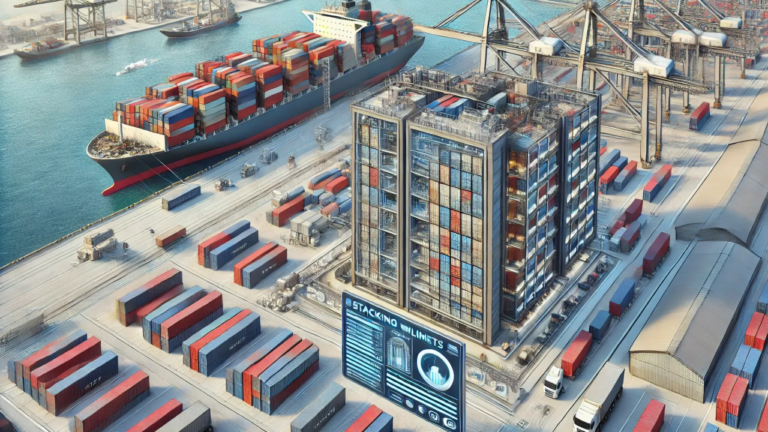Container Stacking Weight Management: An Effective Solution for Safe Shipping
11 October 2024 – Al Mar’atul Hamidah

Illustration of container stacking weight (2024). Foto: Pranala Digital Transmaritim
One crucial aspect of logistics and shipping that must be considered for efficiency and safety is the management of containers, which are often stacked vertically, whether in ports, ships, or warehouses. Stacking weight, or container stacking capacity, refers to the maximum weight a container can support when other containers are placed on top of it.
This concept is vital because improper management of container stacking weight can lead to container damage, operational disruptions, and even accidents with significant consequences. This article will discuss the importance of stacking weight, the factors affecting its capacity, and the latest technology that helps optimize container management in modern logistics.
Definition of Container Stacking Weight
Stacking weight refers to a container’s ability to support the weight of other containers stacked above it without suffering structural damage. This capacity is typically expressed in tons or kilograms and is influenced by several factors, including container material, structural design, and operational conditions.
Generally, shipping containers are made of strong steel or aluminum, designed to withstand significant dynamic and static pressure during sea, land, or air transportation. The stacking capacity considers not only static loads (other containers stacked on top) but also dynamic loads that occur during the movement of ships or vehicles.
Factors Affecting Stacking Capacity
Several factors can affect the stacking capacity of containers:
- Material and Design of the Container: Modern containers are typically made from high-quality steel or aluminum resistant to corrosion and pressure. However, these materials have certain strength limits. Steel containers, for instance, have a higher strength to bear heavy stacking compared to aluminum containers. In addition, the container’s structural design, such as corner placement and reinforcement, greatly influences stacking capacity.
- Stack Height: One of the most critical factors is the height of the container stack. The higher the stack, the more pressure the container at the bottom must bear. Therefore, the containers at the bottom need to have a higher stacking capacity to avoid structural damage.
- Dynamic Loads: Containers transported by sea or rail not only experience vertical pressure from containers above but also dynamic loads from vibrations, shocks, or waves. If these dynamic loads are not considered in the stacking capacity, they can accelerate container damage.
- Weather Conditions: Containers stacked at ports or on ships are also affected by weather conditions. Exposure to strong winds or minor earthquakes can cause container stacks to shift, increasing the load on the bottom containers. Stabilization tools are crucial under extreme weather conditions.
Importance of Understanding Stacking Weight in Logistics Operations
Understanding container stacking weight capacity is essential for maintaining safety and efficiency in logistics operations. Non-compliance with stacking weight limits can cause structural damage to containers, leading to cargo loss or accidents that can have financial and reputational impacts on companies.
According to recent studies published in logistics and supply chain management journals, violations of stacking weight regulations at ports have caused several serious accidents over the past five years. A case study at a major Southeast Asian port showed that failure to comply with stacking weight limits led to the collapse of container stacks, resulting in significant material losses and shipment delays.
iStow Features in Stacking Weight Management
To optimize container stacking weight management, various software and technologies are now available. One leading innovation is iStow. iStow helps simplify container storage planning by calculating optimal stacking arrangements based on container weight, size, and ship layout. This system enhances cargo loading efficiency, ensuring that stacking complies with safety regulations and operational requirements. iStow not only helps balance weight distribution but also monitors potential issues such as overloading or improper stacking, making it a valuable tool for minimizing human error in container management operations.
In modern logistics operations, understanding and managing safe and efficient container stacking weight depend on a combination of technology, strategic weight distribution, and strict adherence to safety protocols. With innovations like iStow, shipping and logistics companies can better optimize stacking weight management, ensuring safe and regulatory-compliant transportation. Good management not only boosts operational efficiency but also minimizes the risk of accidents and losses.
